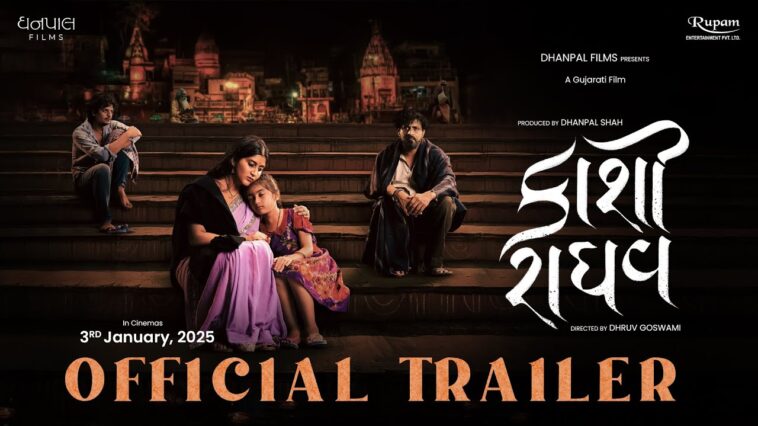Gujarati cinema continues to evolve, showcasing the richness of its cultural tapestry while experimenting with contemporary themes. “Kaashi Raaghav,” directed by Dhruv Goswami, is the latest offering in this vibrant regional cinema. Featuring Jayesh More and Deeksha Joshi in pivotal roles, the film presents a captivating blend of love, revenge, and moral dilemmas. It delivers an engaging story set against the picturesque and culturally significant backdrop of Gujarat.
In this review, we will explore the intricacies of “Kaashi Raaghav,” delving into its narrative, performances, technical achievements, and its impact on audiences and critics.
Plot Overview: A Tale of Complex Interconnections
“Kaashi Raaghav” revolves around the lives of two men, Kaashi and Raaghav, whose paths cross under fateful circumstances. Kaashi, portrayed by Jayesh More, is a man deeply rooted in traditional values and family honor. Raaghav, on the other hand, represents a more modern and morally ambiguous outlook, creating a stark contrast between the two characters.
The story is propelled forward by a series of events that force the characters to confront their principles, emotions, and the choices that define them. Love and vengeance form the crux of the narrative, with each character’s actions reverberating through their shared journey. The film’s layered storytelling adds to its intrigue, keeping audiences engaged as the plot unfolds.
Kaashi Raaghav Movie Review
As a cinematic piece, “Kaashi Raaghav” makes a strong impression. Its strength lies in its ability to blend a culturally authentic backdrop with universal themes of morality and human connection. However, the film isn’t without its flaws, as its ambitious narrative occasionally stumbles in execution.
Performances: A Stellar Ensemble
Jayesh More delivers a standout performance as Kaashi. His portrayal of a man caught between familial obligations and personal desires resonates deeply, reflecting the complexities of his character’s journey. More’s nuanced acting captures the internal struggles and emotional growth of Kaashi, making him a relatable and compelling protagonist.
Deeksha Joshi, as the female lead, brings her A-game to the role. Her character, pivotal to the storyline, is strong-willed and layered, offering a counterbalance to Kaashi’s traditionalism. Joshi’s expressive acting enhances the emotional weight of her scenes, leaving a lasting impression.
The supporting cast also shines, with actors seamlessly blending into the narrative and adding depth to the story. Each character, no matter how minor, serves a purpose, enriching the film’s overall texture.
Direction and Cinematography: A Visual and Emotional Treat
Dhruv Goswami’s directorial approach is ambitious, aiming to balance intricate character development with a captivating plot. His vision comes through in the film’s pacing, which, while occasionally uneven, manages to hold viewers’ attention. Goswami’s understanding of Gujarati culture is evident in his portrayal of the setting, characters, and societal norms, lending authenticity to the film.
The cinematography deserves special mention. The visual depiction of Gujarat, with its serene landscapes, bustling streets, and traditional architecture, becomes a character in its own right. From the vibrant hues of local festivals to the serene tones of rural life, the film’s visuals immerse the audience in its world. Each frame feels deliberate, contributing to the film’s emotional resonance.
Music and Soundtrack: A Melodic Complement
Music plays an integral role in “Kaashi Raaghav,” amplifying its emotional highs and lows. The soundtrack, infused with traditional Gujarati melodies, captures the soul of the narrative. Each song feels like an extension of the storyline, enhancing key moments without overpowering them.
The background score is equally effective, subtly underscoring the tension, joy, and sorrow that permeate the film. The seamless integration of music and visuals makes the viewing experience more immersive.
Themes and Cultural Resonance
One of the film’s most commendable aspects is its ability to tackle universal themes while remaining deeply rooted in Gujarati culture. The juxtaposition of traditional values and modern dilemmas creates a narrative tension that feels relevant and thought-provoking.
“Kaashi Raaghav” also delves into moral ambiguity, presenting characters who are neither entirely good nor evil. This exploration of gray areas challenges viewers to question their own beliefs and biases, making the film more than just a source of entertainment.
Critical Reception: A Mixed Bag
Critics have largely appreciated “Kaashi Raaghav” for its strong performances and cultural authenticity. Jayesh More and Deeksha Joshi have been widely praised, and the film’s visual appeal has drawn comparisons to some of the best works in regional cinema.
However, the film has also faced criticism, primarily for its ambitious narrative structure. While the storyline is intriguing, its execution occasionally falters, with some plot points feeling rushed or underdeveloped. This uneven pacing has been a point of contention, dividing audiences and critics alike.
Audience Response: A Reflection of Impact
The audience’s reaction to “Kaashi Raaghav” has been largely positive, with viewers lauding its emotional depth and cultural authenticity. Social media buzz highlights the film’s ability to resonate with Gujarati audiences while appealing to a broader demographic.
Conversations around the movie often center on its moral questions and character dynamics. This engagement indicates that “Kaashi Raaghav” has succeeded in sparking meaningful dialogue, a testament to its narrative impact.
Technical Achievements: Behind the Scenes Excellence
The technical team behind “Kaashi Raaghav” deserves applause for their contributions. From costume design that authentically represents Gujarati traditions to sound design that enhances the storytelling, each aspect of production reflects meticulous care.
The editing, while not flawless, does a commendable job of weaving together a complex narrative. The transitions between scenes are smooth, and the visual storytelling remains coherent despite the narrative’s occasional missteps.
Conclusion: A Significant Milestone in Gujarati Cinema
“Kaashi Raaghav” is a film that ambitiously aims to push the boundaries of Gujarati cinema. Its exploration of complex themes, combined with powerful performances and a rich cultural backdrop, makes it a noteworthy addition to the regional film industry.
While it isn’t without its flaws, the film’s strengths outweigh its shortcomings, offering a cinematic experience that is both engaging and thought-provoking. For those interested in stories that blend cultural authenticity with universal human dilemmas, “Kaashi Raaghav” is a must-watch.
As Gujarati cinema continues to grow, films like “Kaashi Raaghav” pave the way for a future where regional stories find global recognition, bridging cultures through the power of storytelling.



